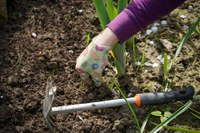Prairie Fare: Weeds: If You Can’t Beat Them, Can You Eat Them?
(Click an image below to view a high-resolution image that can be downloaded)
By Julie Garden-Robinson, Food and Nutrition Specialist
NDSU Extension Service
My flowers and vegetables are growing nicely with the regular rain.
The weeds are doing well, too, so I needed to clean up my gardens recently. I pulled weed after weed that had sprouted in my planters, raised garden beds and ground-level garden patch.
These opportunistic green invaders were hiding under flowers and foliage and in the crevices by the raised beds. Why didn’t all my plants grow as well as the weeds?
I tried to make it fun by playing “name that weed.” No, that wasn’t a fun game at all. I needed a reference book or a weed scientist for consultation.
Years ago, when I was an undergraduate student, I worked as an assistant to graduate students doing their master’s and doctoral degrees in weed science. Weeds, after all, can reduce crop yield and profitability, so research continues on the best way to manage them.
The graduate students quizzed us assistants on weed identification as we counted green foxtail and put tiny straws by kochia under towering sunflowers. We pulled purslane, quackgrass and redroot pigweed.
After days spent counting and pulling weeds, I dreamed about weeds. Maybe those were nightmares.
As I continued to plunder the weeds in my gardens this week, two rabbits looked at me through the fence from my neighbor’s yard. I pondered training the rampant rabbit population to eat weeds instead of my petunias, pansies and impatiens.
Fortunately, my backyard gardens are guarded from rabbits by three dachshunds.
Despite my early work doing fieldwork, I did not change my major to become a weed scientist. Therefore, I decided to consult a former weed specialist, Chris Boerboom, who also happens to be our retiring Extension director.
In other words, if I misquote him, I’m probably off the hook. He will be busy packing up his office for his next adventure, where people get to sleep in, go fishing on a whim or pick tender lettuce in their garden any time during the day.
What is a weed, anyway?
According to Chris, “A weed is a plant out of place. Kochia in a wheat field is definitely a weed. Corn is a weed in a field of soybeans. A dandelion is a weed in lawns, but you may grow it as an herb. Personally, I like the tang of a bite of red sorrel, but it is a weed in a field. It all depends on context.”
Dandelions, by the way, can be used raw or cooked all the way from their roots to their blossoms. They also can be fermented to make wine.
I asked Chris some additional questions about edible weeds.
“Lambsquarters, purslane, burdock roots, chicory roots and dandelions are a few weeds on the edible list,” he noted. “Remember that some weeds are toxic, such as nightshades (fruits) and hemlock. Of course, others, including poison ivy, can cause skin reactions.”
Nutrition is my area, so I know that weeds can provide vitamins A and C and some minerals, including potassium.
If you are an aspiring gardener, follow Chris’ advice: “Never let weeds go to seed. Don’t forget about weeding after you have picked the last string bean or cucumber. The last weeds in a garden will still make a crop of seeds for the next year.
“You might also try using a mulch to keep annual weeds from establishing,” he added. “If small seedlings can’t get light, they’ll die a quick death.”
As a food and nutrition specialist, I’ll add a few more safety tips:
- Be sure that you can identify the weeds, and that might mean investing in a book or finding a credible source online.
- Know that sometimes the roots or leaves are edible, and other times, the seeds are edible.
- Avoid weeds that have been sprayed with pesticides or other chemicals. Don’t pick edible weeds collected along roads because exhaust can leave residues on plants.
- Finally, add only one weed at a time to your diet and check for allergic reactions.
On the NDSU Extension “Field to Fork” website (https://www.ag.ndsu.edu/fieldtofork), we have a free weed identification guide. North Carolina Extension also has a section on edible weeds in its gardener handout book. It’s free online (https://tinyurl.com/NCExt-EdibleWeeds).
Although I probably won’t be gathering a pile of weeds to eat this year, I will be harvesting the tender lettuce I protected from the invading weeds. This salad dressing is similar to one I grew up eating with leaf lettuce right from our garden.
Lettuce Salad With Creamy Salad Dressing
1/2 c. sugar
1/4 c. apple cider vinegar
1/2 c. half-and-half cream
8 c. lettuce
Mix ingredients together, chill and toss with leafy greens right before serving. If desired, top with chopped onions and tomatoes.
Makes eight servings. Each serving has 70 calories, 1.5 grams (g) fat, less than 1 g protein, 14 g carbohydrate, 0 g fiber and 20 milligrams sodium.
(Julie Garden-Robinson, Ph.D., R.D., L.R.D., is a North Dakota State University Extension food and nutrition specialist and professor in the Department of Health, Nutrition and Exercise Sciences. Follow her on Twitter @jgardenrobinson)
NDSU Agriculture Communication - June 21, 2018
| Source: | Julie Garden-Robinson, 701-231-7187, julie.garden-robinson@ndsu.edu |
|---|---|
| Editor: | Ellen Crawford, 701-231-5391, ellen.crawford@ndsu.edu |



